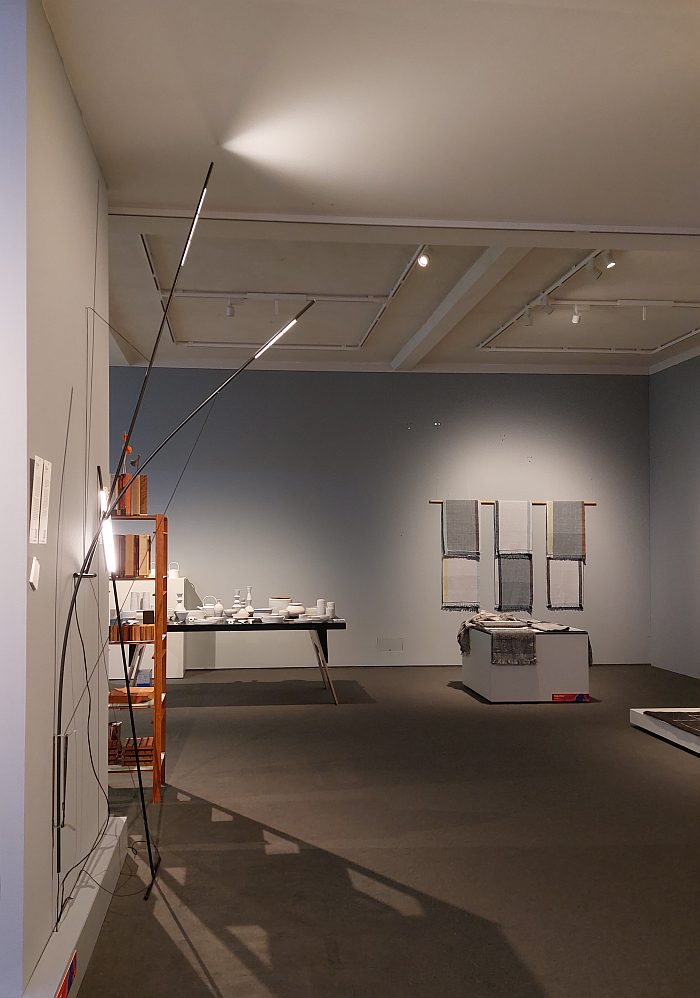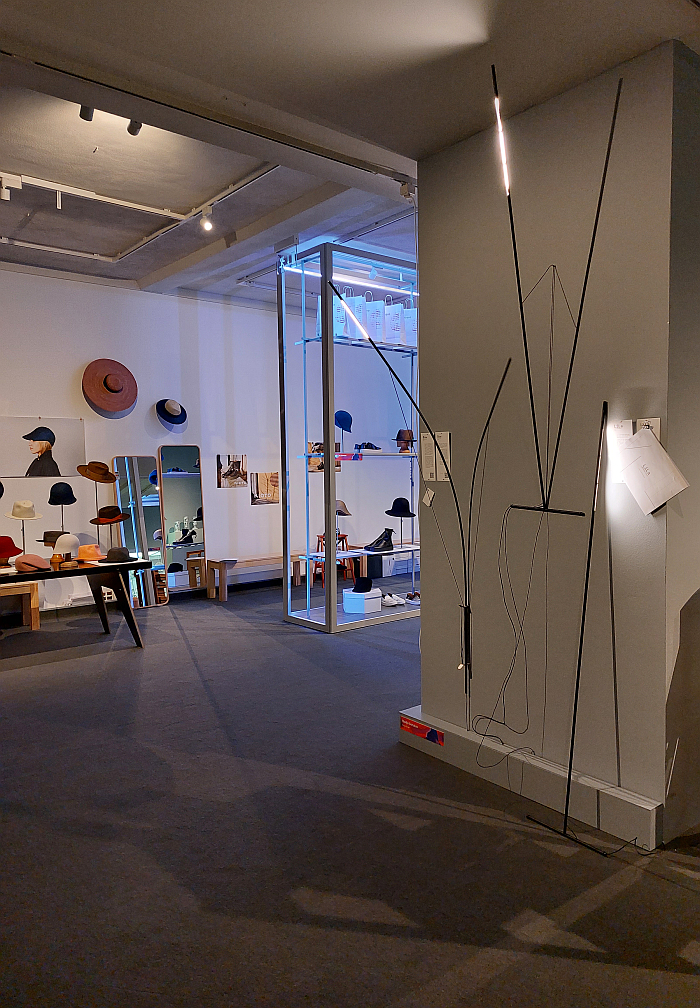
Following on from the co-winners of the inaugural Grassimesse smow-Designpreis Hevesi Annabella/Line and Round and Cornelius Réer the winner of the 2nd edition is Burg Giebichenstein Kunsthochschule, Halle, Interior Architecture Masters student, Nadja Schulze for her lighting projects LiLa, Bow and 360°.
The latter a wall mounted lamp, family of lamps, that can be rotated through, well... 360°. A rotation that not only results in the cable being spooled in or spooled out depending on the direction of rotation, a playful touch inspired by the automatic cable retractor system of a vacuum cleaner, something which tends to imply that an alert and open mind can find inspiration anywhere, and thereby helping reinforce the designer's singular active viewing of the world we all passively navigate every day, but an also an aesthetic touch, a spatial design touch, as through the rotating of the shade the illumination provided by the light source on the underside of the discs continually changes. Or goes out if you wind the cable so far in that the plug no longer reaches the socket. And is left hanging in space, thereby giving the impression of a child's balloon either trapped or a little too heavy to float away.
The middle-most a wall lamp inspired by tent poles — see above and automatic cable retractor systems — that in addition to being bendable, bow-able, positionable, via a very simple, non-mechanical system, i.e. a rope, that other tent construction essential, is also, if we've understood correctly, the precursor to that which is the primary focal point, pun intended, of Nadja's Grassimesse 2024 presentation and, arguably, of Nadja's current work: LiLa, Lightweight Lamps.
A modular system, and thus, arguably, that which designers should develop for series production rather than individual objects, that foresees the free connecting of a number of elements to create floor, wall or pendant lamps. Including the connecting of several lighting elements to create long chains of light rather than the single sources as presented at the 2024 Grassimesse. LiLa lamps that don't bend as Bow does can be moved in and out of the space, moved closer or further away from the wall; but whose light-head, as with Bow, and as with 360°, is rotatable through, well... 360°, thus enabling an instantaneous, and highly intuitive, switch between direct or indirect, focussed or atmospheric, bright or diffuse, illumination.
A very satisfying ease of intuitiveness that units all three lamps, as does their comfort in their analogousness in an age of smart digital technology, as does their pleasing graphic quality, they, we imagine, we've only seen them in the Grassi Museum's exhibition hall, but imagine they will contribute as structures as much as lights to a space, whereby they all express themselves with a filigree, unobtrusive, character. The latter a fact that shouldn't surprise in context of Bow and LiLa seeing as they are inspired by filigree, unobtrusive, tent poles.

An inspiration that reminds that Michele De Lucchi's Tolomeo lamp was inspired by the vernacular trabucchi fishing rods/nets of Apulia, southern Italy; fishing rods and tent poles being when not identical then certainly closely related, at least physically, but very different functionally, which is well worth reflecting on. And also tending to imply that getting out in the fresh air is not only good for refreshing the brain, but the things you meet in that fresh air can stimulate that refreshed brain.
Tent poles that also remind of an Eileen Gray's rejection in 1929 of what she referred to as "the 'camping' style'"1, so transitory, mobile, furniture, a type of furniture that, we imagine much to Eileen's displeasure, has become firmly established in the intervening century for a variety of reasons; and a transitory, mobile character, also expressed by Bow and LiLa, both physically, LiLa being as it is modular, but for all conceptually in that the ease with which they can be repositioned and the light redirected, and also their unobtrusiveness, should allow them to transmit a sense of impermanence while being a permanent feature of a space.
And tent poles that very much were a focus of the 2024 Grassimesse Jury's decision to award the 2024 smow-Designpreis to Nadja, specifically, as was noted in the laudation, the fact that "an existing industrial product is repurposed, its properties optimally employed for a completely new function", words that very much echo Jasper Morrison's assertion in context of the 1984 exhibition Kaufhaus des Ostens that "Marcel Breuer seeing a pair of bicycle handle-bars decided to make chairs using the same industrial process. The new world constructor seeing a pair of bicycle handle-bars decides to use them as they are and save himself the trouble and expense of bending the tube"2. Albeit an echo that the intervening 40 years of social, political, ecological, economical, technical et al changes have altered the tone of: Jasper's new world constructor used handlebars as they are as the base for a table, Nadja's new world constructor takes advantage of contemporary technology to propose a light family based on an existing industrial product used, essentially, as it is but modified to be responsive to contemporary demands, needs, society and interiors. That development of concepts and positions over time that is so essential, fundamental, to enabling design and designers to contribute to a world and global society that isn't static. And which means that nor a Morrison nor a De Lucchi nor a Gray nor a Breuer could have arrived at LiLa and Bow simply because society, technology, design weren't at a stage that would allow them to conceive and approach such. Although all got close. We now are at that stage, and the job of designers is to find meaningful expressions for the now that also offer options for the future. Such as Bow and LiLa.
Whereby, yes, we do very much like the challenge to the now inherent in their uncompromising analogousness
And, yes, we have use the words like, "foresees", "propose" "should", for LiLa, Bow and 360° are works in development, well developed, very well developed, but not yet on the market. Approaching the market is very much the next step for Nadja.
That and completing her Masters.
LiLa, Bow and 360° by Nadja Schulze and all other projects selected or invited to participate in the 2024 Grassimesse Leipzig can be enjoyed, viewed, engaged with until Sunday October 27th at the Grassi Museum für Angewandte Kunst, Johannisplatz 5-11, 04103 Leipzig.
And here you can find our post-Grassimesse interview with Nadja Schulze.
Full details of the 2024 Grassimesse, including opening hours and ticket prices, can be found at www.grassimesse.de
As far as we're aware Nadja Schulze doesn't have a website but her Instagram channel can be found @nadjashlze




1Description [of E.1027], L'Architecture vivante, Automne & Hiver 1929, page 28 The text is uncredited, was probably a joint effort by Eileen Gray and Jean Badovici, but let's assume it was Eileen Gray alone.....
2Jasper Morrison, The Poet will not Polish, in Andreas Brandolini, Jasper Morrison, Joachim Stanitzek, Kaufhaus des Ostens, c kdo + verlag zweitschrift, Hannover 1984